Coronavirus (COVID-19) mitigation measures among children and young people: evidence base summary
Summary of the Scottish evidence base on the COVID-19 mitigation measures aimed at children and young people in Scotland
6. Impacts of COVID-19 mitigation measures
6.1 Evidence from children and young people
Questions asking whether young people agree or disagree with the following statements were included in the representative Young People in Scotland Survey 2021 in February and early April 2021 (5 point strongly agree – strongly disagree):
- Wearing face coverings makes me feel anxious
- Other people have made me feel uncomfortable for wearing a face covering
- It’s harder to connect with other people when one or both of us is wearing a face covering
- I find it difficult to understand teachers when they are wearing a face covering
- I find it more difficult to follow lessons when teachers are wearing face coverings.
6 out of 10 secondary pupils (61%) disagreed[36] that wearing face coverings made them feel anxious, while 18% agreed. 7 out of 10 secondary pupils (70%) disagreed that other people have made them feel uncomfortable for wearing a face covering, while 11% agreed.
Girls in the sample were more likely to agree that they felt anxious because of face coverings than boys (24% compared with 11%), as were those with a physical or mental health condition (28% compared with 12% of those with no health condition)[37]. Girls and respondents with a health condition were also more likely to agree that other people made them feel uncomfortable for wearing a face covering than boys (14% compared with 8%) and those with no health condition (17% compared with 8%).
Figure 6.1 shows that those living in the most deprived areas of Scotland[38] (SIMD 1 and 2) were more likely to agree that wearing a face covering made them feel anxious (22% and 23% respectively) than those living in less deprived areas (SIMD 4 – 13%). The percentage that disagreed that face coverings made them feel anxious increased as the area of deprivation decreased, from 51% in SIMD 1 to 69% in SIMD 4 and 5.
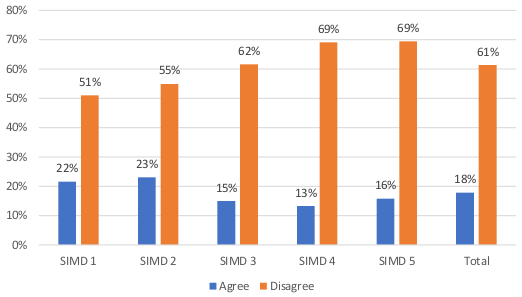
Chart showing the breakdown of young people who agree/disagree with the statement “Wearing a face covering makes me feel anxious” by the Scottish index of Multiple Deprivation (SIMD). The data are from the Young People in Scotland 2021 Survey.
Source: Young People in Scotland 2021, Sample size: 1,361
More mixed results were reported on trying to connect with others while wearing face coverings. 4 out of 10 secondary pupils (44%) agreed that it was harder to connect with other people when one or both of them was wearing a face covering, while 37% disagreed. Girls were more likely to agree that it was harder to connect due to face coverings than boys (50% compared with 39%).
The questions on the impact of face coverings on the education of young pupils revealed that 41% of the pupils agreed that it was difficult to understand teachers when they were wearing a face covering (34% disagreed) and 32% agreed that it was more difficult to follow lessons when teachers were wearing face coverings (though 40% disagreed).
Girls were more likely to agree that it was difficult to understand teachers because of face coverings (47% compared with 35% of boys), as were non-white pupils[39] (53% compare with 40% of white pupils) and pupils living in an urban area (43% compared with 32% of those living in rural areas). Girls were also more likely to agree that it was difficult to follow lessons when teachers were wearing face coverings (35% compared with 29% of boys), as were pupils with a health condition (40% compared with 30% of pupils with no health condition) and pupils living in an urban area (33% compared with 26% of those living in a rural area).
As Figure 6.2 shows, those living in the most deprived areas of Scotland (SIMD 1 and 2) were more likely to agree that it was difficult to understand teachers because of face coverings (47% and 48% respectively) compared with those living in less deprived areas (32% in SIMD 4).
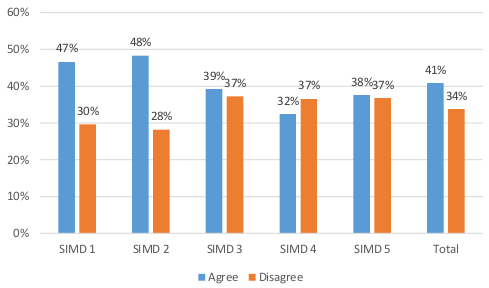
Chart showing the breakdown of young people who agree/disagree with the statement “I find it difficult to understand teachers when they are wearing a face covering” by the Scottish index of Multiple Deprivation (SIMD). The data are from the Young People in Scotland 2021 Survey.
Source: Young People in Scotland 2021, Sample size: 1,361
The survey also included two agree/disagree statements around the rules for meeting others (5 point, strongly agree – strongly disagree):
- The rules around meeting others are having a negative impact on my relationships with my friends and family
- The rules around meeting others are having a negative impact on my mental health.
Almost half of the secondary pupils in the survey agreed that the rules around meeting others were having a negative impact on their relationships with family and friends (46%) and a negative impact on their mental health (48%), while a quarter of the respondents disagreed and the rest neither agreed nor disagreed.
Agreement that the rules around meeting others had a negative impact on their relationships with family and friends and on their mental health was higher among girls (52% compared with 42% of boys), respondents with a physical or mental health condition (54% compared with 43% of pupils with no health condition) and white pupils (49% compared with 29% of non-white pupils).
As Figure 6.3 shows, the percentage of those who agreed that the rules negatively affected their relationships increased with school year. In S1-S3, 39-42% of the pupils surveyed agreed with the statement compared with 52-55% in S4-S6.
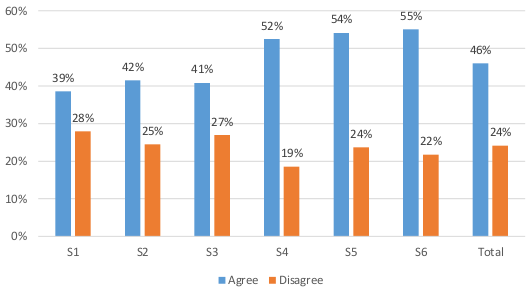
Chart showing the breakdown of young people who agree/disagree with the statement “The rules around meeting others are having a negative impact on my relationships with my friends and family’” by school year (S1-S6). The data are from the Young People in Scotland 2021 Survey.
Source: Young People in Scotland 2021, Sample size: 1,361
The negative impact of the rules around meeting others on respondents’ mental health was particularly pronounced among girls (60% agreed compared with 36% of boys), white pupils (51% compared with 25% of non-white pupils) and those with a health condition (60% agreed compared with 40% of those with no health condition).
The percentage of those who agreed that the rules were negatively affecting their mental health increased with the school year. In S1-S3, 34-42% of the sample agreed with the statement, compared with 55% and 59% respectively in S4 and S5 and 70% in S6. See Figure 6.4 below.
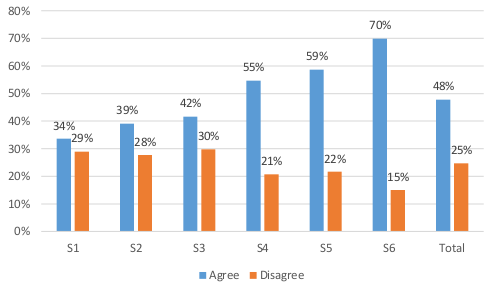
Chart showing the breakdown of young people who agree/disagree with the statement “The rules around meeting others are having a negative impact on my mental health” by school year (S1-S6). The data are from the Young People in Scotland 2021 Survey.
Source: Young People in Scotland 2021, Sample size: 1,361
As noted above, the Lockdown Lowdown 2 focus groups found that most participants agreed with physical distancing, face coverings and appreciated the safety measures taken by educational establishments.
With regards to physical distancing, disabled participants that were hard of hearing or partially sighted found that the 2 metre physical distancing requirement made it hard for them to hear/see others.
However, a participant with autism found the increased personal space beneficial. A question was raised by one participant about their sports team not being allowed to play, and felt that this negatively impacted their mental health in a way that outweighed COVID-19 safety concerns.
There were no concerns raised about face coverings other than the lack of compliance and enforcement discussed in section 4.1 above. One disabled participant had experience of a further education teacher using see through face coverings, and found this a positive experience.
6.2 Evidence from parents
The CEYRIS Round 2 in November-December 2020 included the following questions on face coverings (5 point strongly agree – strongly disagree):
- My child is happy to wear a face covering
- My child seems unfazed by others wearing face coverings
- My child gets upset at seeing others wearing face coverings
- My child finds it difficult to understand people speaking if they are wearing a face covering.
The majority of parents/carers in the survey disagreed that their child got upset when seeing others wearing face coverings (83%) and agreed that their child seemed unfazed by others wearing face coverings (81%). 41% of the parents/carers in the sample disagreed that their child found it difficult to understand people speaking if they were wearing a face covering, while 36% agreed. 56% of the sample agreed that their child was happy to wear a face covering, while 30% disagreed. See Figure 6.5 below. Agreement that their child was happy to wear a face covering was higher among parents of 5-7 year olds (65%) than of 2-4 year olds (42%).
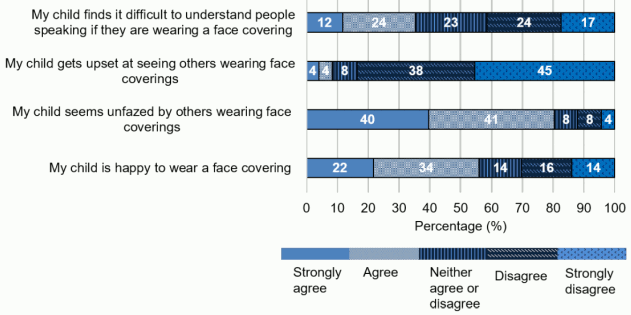
Chart showing the proportion of parents who strongly agree/agree/neither agree nor disagree/disagree/strongly disagree with the following statements:
- My child finds it difficult to understand people speaking if they are wearing a face covering
- My child gets upset at seeing others wearing gace coverings
- My child seems unfaxed by others wearing face coverings
- My child is happy to wear a face covering.
The figure contains 4 charts – one for each statement. The data are from the CEYRIS Round 2 Survey.
Source: CEYRIS Round 2. Excludes refused (prefer not to say) and missing answers. Excludes ‘Not Applicable’ responses.
YouGov weekly polling carried out for Scottish Government from 11-12 May 2021 showed that 58% of the parents in the sample agreed that they were concerned about the longer term effect of the pandemic on their child (21% disagreed) and 47% agreed that they were seeing changes in the way their child played/behaved as a result of the pandemic (33% disagreed). 40% disagreed that they were worried about their child’s mental health, while 39% agreed that they were worried. Parents of children aged 12-17 years old were more likely to worry about their child’s mental health (49% compared with 35% of parents with children aged 0-11) and the longer effect of the pandemic compared with parents with younger children (66% and 54% respectively). Women were more likely than men to agree that they could see changes in the way their child behaved and played as a result of the pandemic (54% and 40% respectively)[40]. See Figure 6.6 below.
There was a decrease in parents worrying about the impact of the pandemic on their child’s mental health: 71% of parents with children aged 17 and under were worried in the polling from 23-24 March 2021, compared with 39% of parents with children aged 4-18 years old in 11-12 May 2021. To be noted that in March the question was asked in a different way, using the statement ‘I have worried about the impact of the coronavirus situation on my child/children’s mental health’.
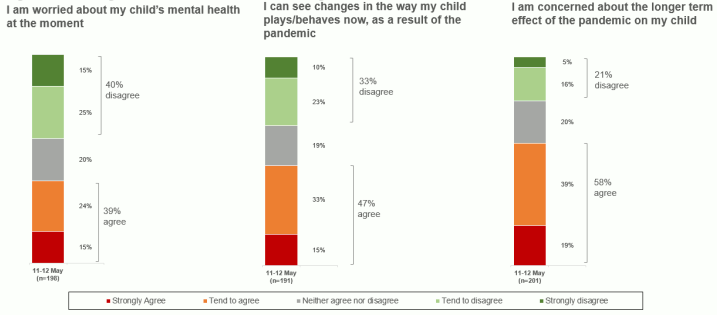
Chart showing the proportion of parents who strongly agree/tend to agree/neither agree nor disagree/tend to disagree/strongly disagree with the statements:
- I am worried about my child’s mental health at the moment
- I can see changes in the ay my child plays/behaves now, as a result of the pandemic
- I am concerned about the longer term effect of the pandemic on my child.
The figure contains 3 charts – one for each statement. The data are from YouGov weekly polling 11-12 May 2021.
Source: YouGov polling 11-12 May 2021; ‘Not applicable’ option excluded.
Contact
Email: socialresearch@gov.scot
There is a problem
Thanks for your feedback